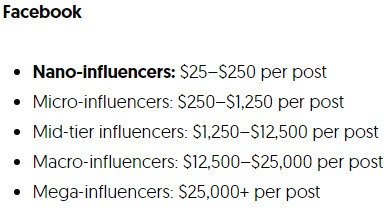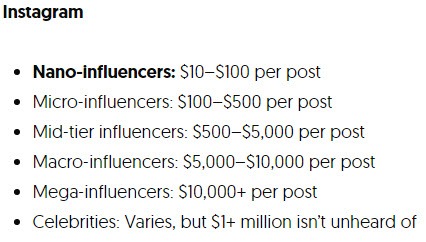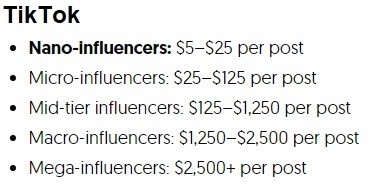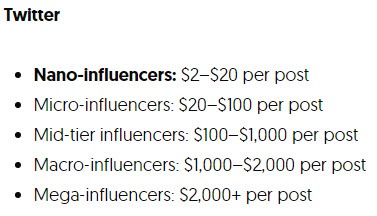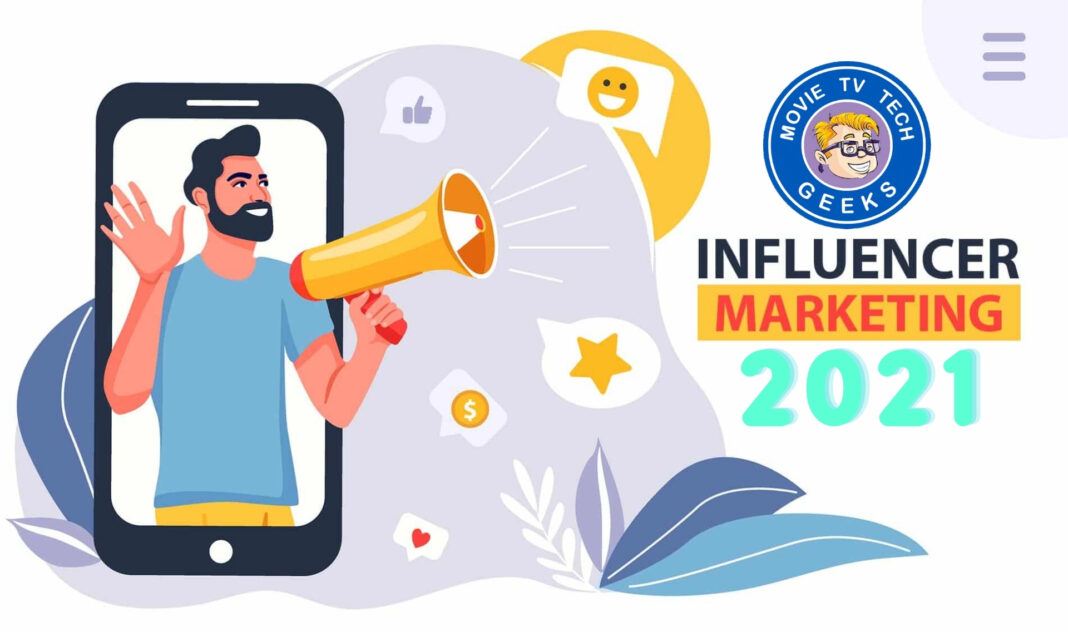
Social media influencers saw a big change happen in 2020 when companies shifted their marketing strategies due to the worldwide pandemic. 2021 will see some major changes as brands move further away from A-list celebrities to more authentic and authoritative social media influencers.
Our third session’s Power Point presentation can be found here in PDF format.
This series is part of speaking engagements that Movie TV Tech Geeks has been doing with Wellness In the Woods about social media. You can see our last article which covered steps on becoming an authoritative social media influencer.
Guide to Influencer Marketing
Influencer marketing is a special type of marketing. Brands and companies will hire an influencer (typically a social media user with thousands of fans or followers) to promote their new product or service.
The cool thing about being an influencer is that anyone can do it. You don’t need special software or skills to get started down this lucrative path. However, you need to understand a few things before you begin your career as an influencer….
Understanding Paid Posts
A paid post is a post that you create specifically to promote a product or company. The purpose of this paid post is to garner attention from your viewers or followers and direct toward the brand that’s paying you.
Most companies have a target audience. That means they have dialed into a specific niche and are looking for influencers within that niche. This means that the niche you choose will determine which brands you work with. For example, if you are in the pet niche, you may have a dog food company reach out to you.
You might think paid posts only come to those who have an extremely high number of followers, but that’s not always the case. It’s not just about the numbers that you have. It’s about the relationship that you have with the people who follow you. If you have a small but engaged audience who regularly interacts with your posts, you can still find plenty of brands that might be interested in partnering with you.
Keep in mind that you want to show companies and businesses that you’re an established leader within your niche. Brands look for persuasive influencers who have plenty of conversations, hashtags and retweets pointing back to them.
If you’re on a platform and a brand approaches you with the offer of a paid post, they’ll usually offer you money in exchange for you mentioning their products or showing your followers that you’re using their items.
Sometimes, a brand may offer you a product instead of money. For example, if you’re a fashion blogger, a clothing company may send you a free sweater in exchange for talking the brand up on social media.
The important thing to remember in this situation is that you’re still being “compensated” even if it’s not in the form of actual dollars. That means you need to be transparent and reveal the relationship you have with the third-party, such as being an affiliate, and explain that you received compensation for giving your honest review.
If you don’t disclose this information in your post, it may become public knowledge later. Once that happens, your brand will be damaged and your followers won’t trust your recommendations anymore. Always make it a point to be honest about what you received in exchange for your review.
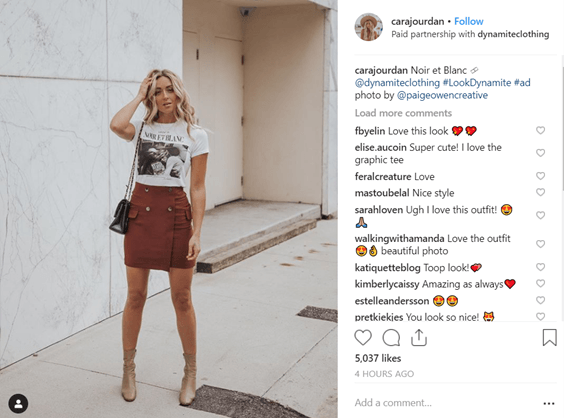
One influencer that does a good job of tagging her posts is fashion and lifestyle user Cara Jourdan (@CaraJourdan). On a recent photo, there’s a quick note under her username that reads: “Paid partnership with dynamiteclothing.” She also tagged the Instagram photo with the hashtag #ad so her followers would understand she was promoting a specific brand.
Because she’s being honest and open about this, Cara’s followers still respect her recommendations and trust her judgement. Note that while Cara’s following doesn’t number in the millions, her engagement rate is high. This makes brands want to use her for their promotions.
As an influencer, should you accept a paid post? Yes, if the brand is legitimate and it won’t hurt your reputation. If they have sleazy practices or have controversy surrounding them, then no amount of money offered could make up for possibly damaging your own reputation if you link with them.
Attracting Sponsors
Now that you understand how paid posts work, you’ll want to focus on attracting sponsors (the brands and companies that pay you). Many influencers build a nice income simply by having 3-5 sponsors. Knowing how to find these sponsors is an essential part of building your reach and your income.
You may eventually become popular enough that sponsors come to you with no prompting. However, if you’re like many influencers, especially those who are just starting out, you won’t automatically get your name in front of brands.
You need to seek them out on your own. You can reach out and tell the sponsors about your audience and the potential market that’s there for their brand. It doesn’t matter if your following is only a few thousand or if you’re new on the scene.

It’s all about the picture that you can paint for your sponsors. You sell them on the fact that your followers are their target audience and you show them the influence you’ve already established.
It can be helpful to promote a product or two on your Instagram that you are not being sponsored for. Once you have plenty of hearts, shares, and comments, you can show this engagement rate to a brand. When they see that you’ve already started selling to your audience, they’ll be more likely to take a chance on you.
While you want to hook sponsors based on the buying power of your audience, you also have to do your homework. Learn as much as you can about your audience. You can do this by running polls, posting surveys, and using similar information gathering tactics.
When you’re ready to approach brands, have this content put together and ready. For example, you might say, “Sixty percent of my followers are looking for lip color that lasts all day with no need to reapply. Your all-day, all-night lip-gloss would be a great fit for my followers. Ninety percent of my fans are between the ages of 18-35, which is your target demographic according to the research I’ve done on your brand.”
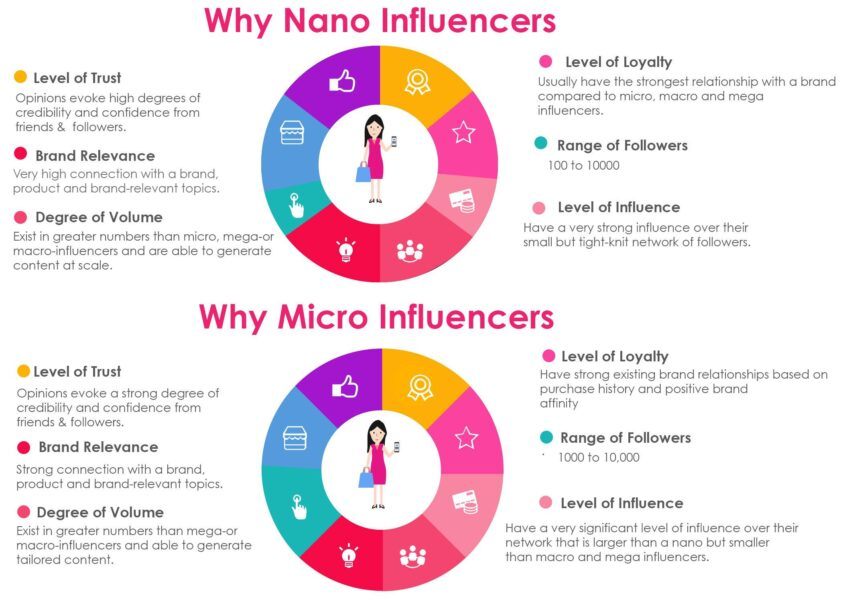
Sponsors are eager to partner with an influencer that can show how their authority is helping other people to better themselves or their lives because it carries a positive message.
Don’t forget the power of your story. You can approach sponsors with how and why you got started in your niche. However, make sure you tap into human emotion because this is universal.
For example, people understand and empathize with a beauty blogger who got involved in teaching makeup tutorials to help women who’ve been scarred.
Sponsors love the idea of hiring influencers who have a heart for others. It’s good for their business when their potential customers see them in partnership with someone who’s trying to make the world a better place.
Share with a potential sponsor what it is you do on your platform. This is where you divulge the why behind the action.
For example, you promote skin care tips because you have a family member with skin cancer. Or you had a friend who struggled with acne. This is your motivation for creating your place in the niche.
Then show the sponsor how they’re going to profit by coming aboard your platform space. You want to make sure any sponsor sees and understands exactly what they’re getting and the possibilities available for them.
Once you show them how they stand to profit, be specific, and let them know what it would cost them to promote with you. If you’re just starting out, you might be tempted to ask for less than what you’re worth. Don’t do this because in marketing it’s about perceived value.
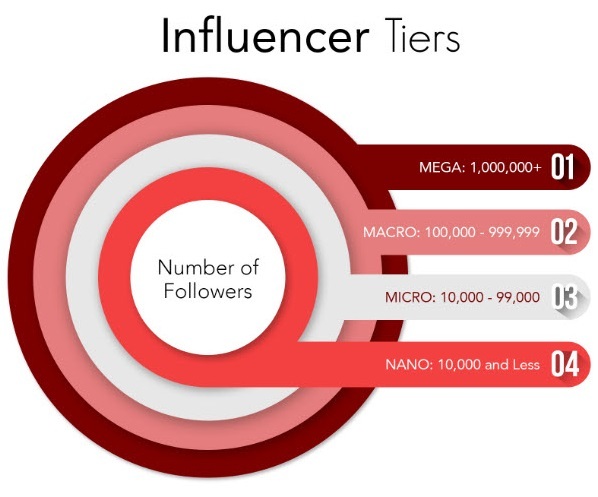
A brand will hesitate to work with someone who asks for $250 but won’t bat an eye at the influencer who asks for $2,000. The higher charging influencer has a greater perceived value. They look at the more expensive influencer as an “investment” that they’ll make back, in terms of profit. However, the influencer that’s under-charging will be viewed as an “expense.”
Now you may be wondering how you should set your price. There are several ways you can do this. You might set your price based on the number of followers that you have. You could also base it on the number of posts or images the brand wants you to promote.
Social Media Influencer Pricing Guide 2021
You can use the above image of social media influencer tiers for each level below.
Facebook Influencer Pricing Guide 2021 Instagram Influencer Pricing Guide 2021 TikTok Influencer Pricing Twitter Influencer Pricing 2021
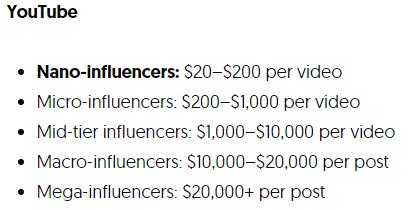
For bloggers or news websites, the pricing is $60 for every 1,000 daily unique visitor received on your site.
When thinking about pricing, take into consideration if the brand wants you to promote it solely on one of your platforms like Instagram or if they want you to promote across all your platforms like Twitter, Instagram, and Facebook. The more platforms you’ll be posting on, the more you should increase your price.
Be honest with what brands can expect from you. Don’t make promises you can’t deliver. It can be tempting to throw out numbers just to impress a company or business, but you don’t know for sure how your followers are going to react or what the conversion rate will be.
However, you can point to past successes. For example, you might have done an eyeshadow tutorial and mentioned a specific brand even though you weren’t compensated for it. However, you know from what your audience has told you that at least 50 followers bought the new palette that you promoted. You can explain this to your sponsor so they know what your reach is like.
When you approach a brand, remember that what you’re offering is your voice and your personality. That’s one hundred times more valuable than another sterile ad that their target market will overlook in their busy newsfeed.
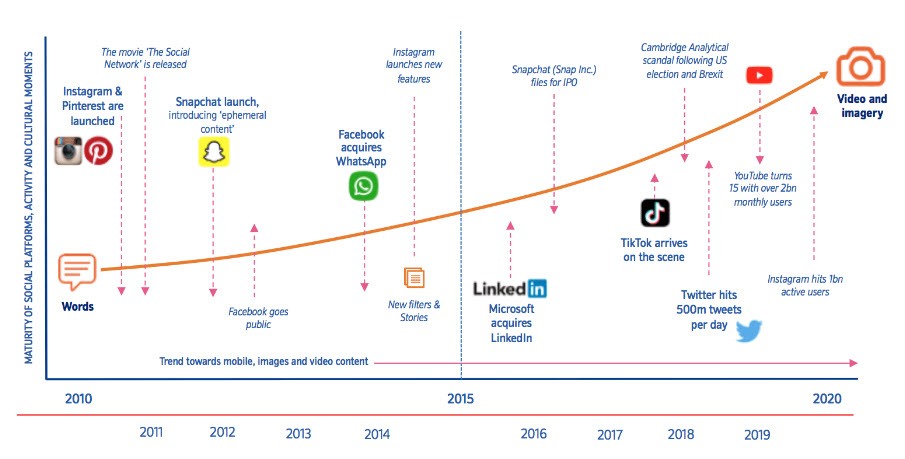
The Different Types of Sponsorship
Before you can begin earning money as an influencer, you need to keep in mind that there are several different types of sponsorships. You need to know what they are and understand how they work before you approach a brand.
The first type of sponsorship you might encounter is simple selling. The brand just wants to use your voice and your influence to persuade people to give their business a try. Typically, they’re looking for new customers who have never purchased a product from them before.
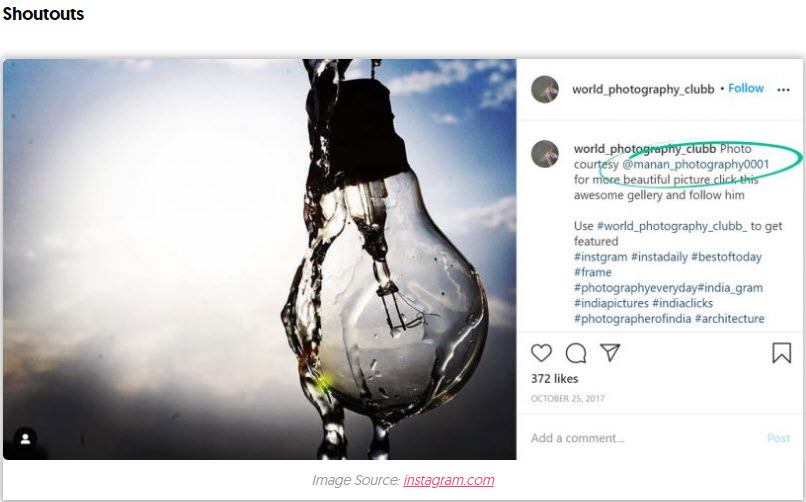
Often, the brand will give you a special coupon code that you pass onto your followers. When your fans go to make a purchase, they can use the code to get a special discount or another perk, like free shipping.
Lynn Terry (@lowcarbtraveler), an influencer who is in the ketogenic diet niche, did this in a recent post on Instagram. She posted a photo of keto granola that she enjoyed. Then in the caption she invited followers to DM her for a special coupon code.
She also posted an Instagram Story that linked to the granola website. This made it easy for her followers to find her link and try these tasty new treats.
Keep in mind that it doesn’t always have to be a discount code that you share with your followers. Sometimes, a brand might give you a coupon code for “free shipping” on an order or a “buy one, get one” deal that you can let your followers know about.
Another type of sponsorship could be a special perk. This is something you can pass on to your followers that’s exclusive to them. It should be a specific item that appeals to your target market.
For example, a sponsor might offer your followers a gift for clicking through the link that they give you to share. This gift could be a set of makeup brushes to go along with the purchase of a makeup kit.
Keep in mind that perk can be anything and it doesn’t necessarily have to be something that’s tangible. If you’re a travel influencer, then a sponsor may offer a free night or two stay at an exclusive hotel if your followers click on a specific link.
Sometimes sponsors will use giveaway events. This is usually done to increase brand awareness. You’ll host the contest on your social media channels. Winners might be chosen randomly or picked because they completed a special step such as signing up for the company’s newsletter.
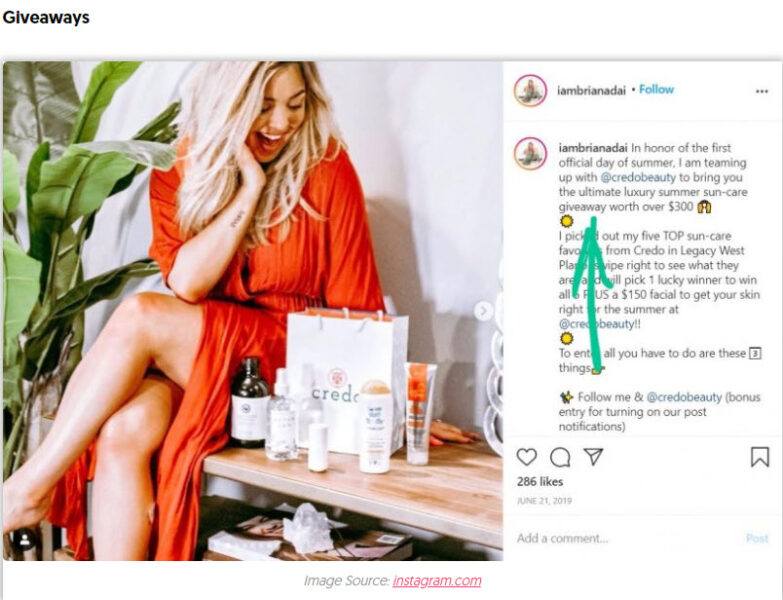
Tamanna Roashan (@DressYourFace) is a beauty influencer who partnered with Morphe Brushes (@MorpheBrushes) to do an exclusive giveaway.
To be entered to win, Participants had to complete three steps. First, they needed to be following both Tamanna and Morphe Brushes on Instagram. Next, participants had to tag three friends in the comments, and finally, they had to like the post.
The cool thing about this is that the likes and comments created more engagement on the post. As the engagement number rose, Instagram’s algorithms kicked in and began displaying the post to even more users. In six days, the giveaway received over 21,000+ hearts and 15,000+ comments.
Sometimes, a sponsorship may not involve a discount, special perk, or giveaway. In these cases, the sponsor may just want you to promote their content.
For example, a makeup company may want you to promote a link to their beauty quiz where your followers can discover their ideal makeup coloring. When your followers click on the link to take the quiz, it can create interest in the company’s products.
Now that you understand the different types of sponsorship, you’re ready to focus on the next step of becoming an influencer: understanding takeovers.
What Are Takeovers and Why Are They Important?
A takeover is a marketing tool. It’s giving someone else the temporary control of your platform or taking over theirs for a specific allotted time.
You can invite someone to do that for your account or you can accept an invitation to do it on someone else’s profile. If you’re on the fence about how well you’d like this kind of endeavor, once you learn what a takeover can do, you won’t be.
A takeover isn’t about struggling to increase your influence all on your own. You get to mesh with another influencer in a combined endeavor. You’ll be able to take your brand to their followers and they’ll essentially get their brand in front of yours.
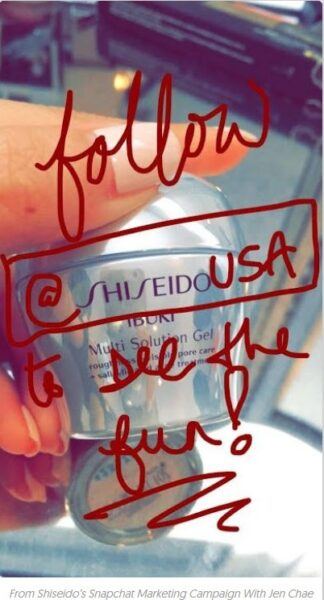
Takeovers aren’t just for growing your brand though. Sometimes, a business or company will ask you temporarily take control of their platform as an influencer for an agreed upon amount of time. Some influencers takeover a brand’s profile for an hour or two. Depending on your industry, a brand may ask you to do a takeover that lasts 1-2 days.
It’s essential that you choose to do takeovers that are relevant to your niche. If a brand that’s known for puppy food wants you to do a takeover and your niche is yoga, then that mix may confuse followers.
One brand that’s smart about takeover is Sony Alpha (@SonyAlpha). They invite photographers to takeover their Instagram account, sharing their latest photos and explaining on how they got the shot.
Because their followers are photographers, their audience loves these takeovers. It boosts the popularity of both Sony’s account and the influencer who is posting.
A takeover can also raise the level of interaction with your own followers. If you do a takeover on someone else’s account, they can follow you over there and engage while you’re interacting with the brand’s audience.
There are a lot of fun things you can do during a takeover. You can host giveaways, have a live chat or do a behind the scenes video. You can also post funny (or serious) selfies, share how you use the brand’s product, or share a tutorial that the brand’s followers can use right away. Remember the content that you provide during the takeover should be something that has value enough to persuade your fans to join in.
You gain a lot when you engage in a takeover. If you partner with another influencer, that person can bring awareness to your platform and introduce their audience to your brand. If you partner with a brand, you can earn money or other perks for your participation.
However, it’s not all fun games. There are some steps you’ll need to follow in order to have a successful takeover.
Ask Questions Before Assuming
First, decide who’s going to do what. If you’re allowing someone to takeover your platform, you want to be sure that it’s an influencer you trust completely.
You also want to be sure it’s someone who has the same commitment to excellence and can stand up to public scrutiny. You don’t want any ugly skeletons coming out of the closet and negatively affecting your reputation.
If you’re going to takeover a brand’s account, then decide ahead of time what your content is going to be based on what the other person’s audience enjoys. You can figure this out just by doing a quick search on which of their posts got the most attention.
If it was a video, a live chat or a short, inspirational speech that resonated with their audience, then you want to present the takeover in the same format.
Plan Your Strategy
Next, you need to sit down and plan a takeover strategy with the influencer or brand that you’re working with. Otherwise, your takeover could quickly become chaotic and you’ll be running over the other person or confusing your followers.
Choose a specific time frame for the takeover. Sometimes it’s for a certain time slot like a couple of hours out of the day or it might be for the entire day.
You need to know how much content is expected from you. For example, a company may think that you’ll be posting 6 times in a day like their last influencer did. However, if you don’t know this information in advance, you may only post four times, which is frustrating to you and the brand.
Bases Covered?
Cover your bases during your strategy session. Consider whether there’s something that the brand doesn’t want you to post. One fashion company might be strict vegans and opposed to the use of furs. If you post a picture wearing a genuine fur coat, followers may get angry and you may damage their brand.
Likewise, if you’re letting someone else do a takeover on your account, consider what you don’t want posted. You don’t want to alienate your audience because the takeover resulted in the other person sharing something that wasn’t cool.
After you get the details ironed out, you need to decide how much of the account you need access to. Different brands have different preferences. One brand may simply hand you their password and change it again once your takeover is finished.
Another brand may want you to send the content you plan to post to their social media consultant who will schedule the posts for you. It all depends on what you and the brand decide to do.
Remember a takeover works best when it’s a give-give relationship. If you decide on a takeover, think about the benefits for both of you. Are you doing this to boost your followers? Will you use this opportunity to send traffic to a specific link? Are you looking to profit from your engagement?
When you’re clear about what you want, you’re less likely to be disappointed. You’ll also enjoy the takeover more and be able to clearly measure if it was successful.
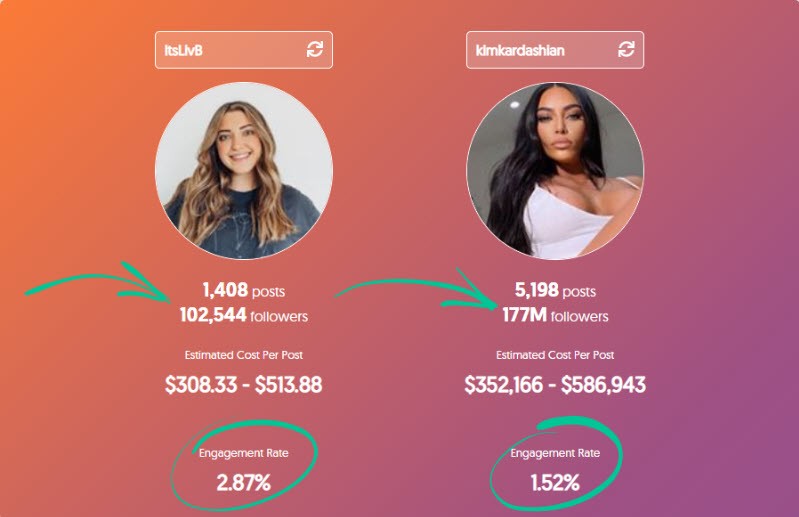
What You Need to Know about Measuring ROI
As an influencer, you may think your job is just to take pretty photos and post them on social media. While it’s part of your job, it’s not the only thing you should be doing. You need to be learning about ROI if you really want to succeed as an influencer.
The term “ROI” is often used by businesses and brands. It stands for “return on investment” and typically means the company spent money in an attempt to make even more money.
If a brand spends $100 on Facebook ads and earns $300 in revenue, then the ROI is $100. For every $1 they spent, they earned an additional $2. Companies use ROI to judge which strategies made money and which ones didn’t result in any profits.
Sometimes, ROI may not be about immediate profits. A company or brand could hire an influencer to increase the number of followers they have on a social media channel. The marketing team knows that building an audience will result in more long-term profits by giving the company a bigger reach.
It’s important that you understand a brand’s goal before working with them. This will help you and the company measure the ROI of your posts.
Before you talk with a brand, do some research on your own about influencer marketing and ROI. Pay attention to what results brands usually see in your niche.
An example is that for every $1 a brand spends in the beauty industry, they can expect about $10 in return. While you can’t promise a certain amount to your client, knowing this statistic can be helpful when you’re negotiating your rates.
Conversion Rate
When it comes to ROI, you should also study your conversion rate. This is the number of users who took action after you made a recommendation or promoted a product. If you have 100,000+ followers and 5,000 people made a purchase, then your conversion rate would be around 5%.
Now, imagine a popular brand offers you a deal—they will pay you $5,000 for a sponsored post or you can get an affiliate commission of 25% of every sale.
Then assume 5,000 followers buy through your link for a product priced at $10. This results in $12,500 in revenue for you. You’ve made $7,000+ than you normally would.
While you don’t have to take affiliate offers like this one, don’t be quick to dismiss them. Give yourself some time to think it over and consider your conversion rate before making an agreement.
Another thing you’ll want to think about when it comes to ROI is how many expenses you and the brand are investing in this campaign. If the campaign requires a photo shoot, makeup artist, hairstylist, or other professional, this amount will drop down the ROI.
Bit.ly Links
To make it easy for you and the brand you’re working with, make sure to use trackable links. Often a company will provide you with a special link that is unique to your post. With this link, the business can easily monitor how many people clicked through to their website based on your post.
Another tactic that can be useful for tracking ROI is conversion pixels. Conversion pixels are invisible pixels (small dots) that are placed on the brand’s website.
From there, a company can monitor where their traffic is coming from. They’ll be able to tell that you sent traffic to their site from your social media post even if a follower didn’t click your link but instead, Googled it or typed in directly into their address bar.
To increase brand awareness and boost the results of your influencing campaign, you may want to work with the business to choose a branded hashtag. One of the most popular branded hashtags was #ShareACoke. The Coca Cola Company used it to increase brand awareness and boost product sales at the same time.
Branded hashtags can be useful for promotions, events, takeovers, contests, product launches and more. Remember when suggesting a branded hashtag, make sure to stop and do some research first.
Check the hashtag. Find out if it is already in use. Is or was the hashtag ever associated with something offensive? Could make the company look insensitive?
Conclusion
Becoming an influencer is like learning to ride a bike. It’s not going to come to you immediately. In fact, you might have a few failed attempts until you learn what works well in your niche and what your followers respond best to.
If you’re not already, you should keep a log of your daily follower count. Then post about what you’re doing to boost that number. As you do this, you’ll get ideas of what activities bring in followers and which ones are wastes of your time.
When someone reaches out to you by commenting on your post, answer them as soon as possible. This will help you build a loyal following and it shows brands that you understand the importance of interacting with your audience.
The best way to attract influencer sponsors is simply by having an engaged audience that you’ve built through transparency and authenticity. You can get this full here in PDF format to take with you and read offline.
Top Influencer Marketing Agencies 2021
Izea: izea.com The granddaddy of social media influencing
Blog Meets Brand: blogmeetsbrand.com Good for newcomers to social media influencing.
Viral Nation: https://www.viralnation.com Does dual role as marketing influencers on Facebook, Instagram, Snapchat, youbue and Musical.ly along with acting as a talent agency for incluencers also. They value your properties properly so you are making the best compensation…along with them.
Kairos Media: https://www.kairosmedia.com/ Founded by content creators, they understand your position. Work with over 30K influencers in Gaming, Fashion, Beauty, Lifestyle, Travel, Fitness, Parenting and Esports.
Fanbytes Agency: https://fanbytes.co.uk/ They focus on Gen Z, aka 13-25 year olds who have grown up with social media. Gen Z interacts much differently to brands than Boomers, Gen X and Millennials.
HypeAuditor: https://hypeauditor.com/en/ They focus on having influencers who are real without fake followers, etc. If you get in with them, you are considered real to clients.
The Influencer Marketing Factory: https://theinfluencermarketingfactory.com/ They focus on TikTok, Instagram and YouTube.
Post For Rent: https://www.postforrent.com/ This company allows you to handle everything yourself or let them handle everything for you. With the latter, they will deliver plans to you that matches your brand values and tone of voice.
Veritone One: https://veritoneone.com/ They focus on YouTube. They are the biggest and best when it comes to YouTube Marketing.
Obviously: https://www.obvious.ly/ International agency with over 400K influencers.


